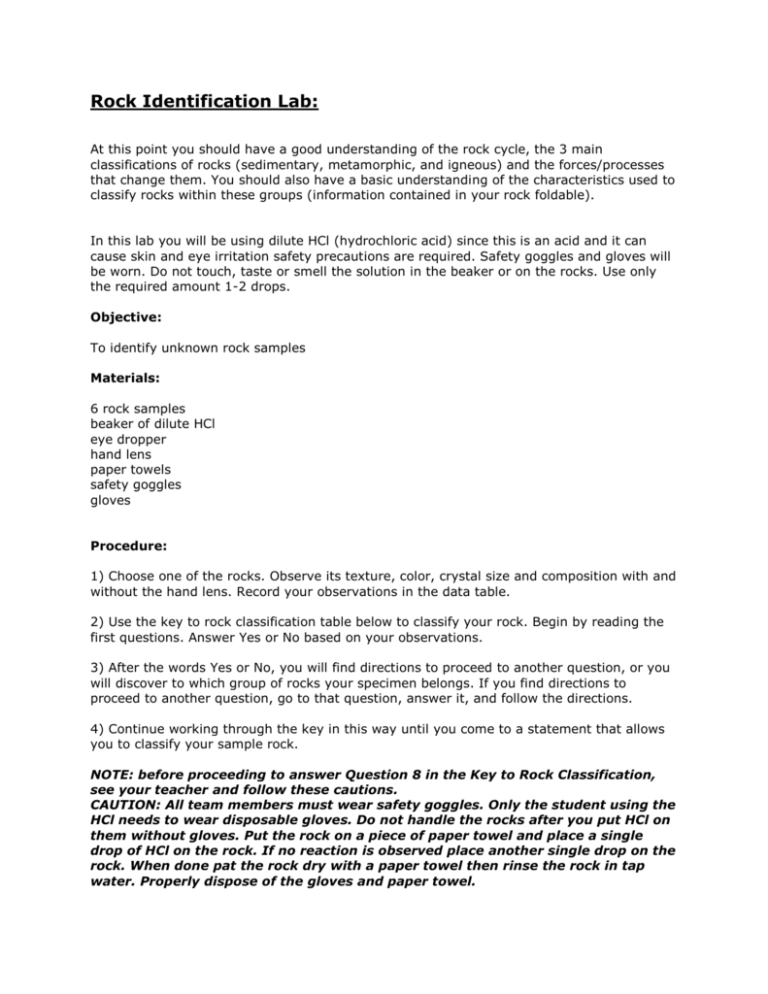Rock Identification Lab:
advertisement

Rock Identification Lab: At this point you should have a good understanding of the rock cycle, the 3 main classifications of rocks (sedimentary, metamorphic, and igneous) and the forces/processes that change them. You should also have a basic understanding of the characteristics used to classify rocks within these groups (information contained in your rock foldable). In this lab you will be using dilute HCl (hydrochloric acid) since this is an acid and it can cause skin and eye irritation safety precautions are required. Safety goggles and gloves will be worn. Do not touch, taste or smell the solution in the beaker or on the rocks. Use only the required amount 1-2 drops. Objective: To identify unknown rock samples Materials: 6 rock samples beaker of dilute HCl eye dropper hand lens paper towels safety goggles gloves Procedure: 1) Choose one of the rocks. Observe its texture, color, crystal size and composition with and without the hand lens. Record your observations in the data table. 2) Use the key to rock classification table below to classify your rock. Begin by reading the first questions. Answer Yes or No based on your observations. 3) After the words Yes or No, you will find directions to proceed to another question, or you will discover to which group of rocks your specimen belongs. If you find directions to proceed to another question, go to that question, answer it, and follow the directions. 4) Continue working through the key in this way until you come to a statement that allows you to classify your sample rock. NOTE: before proceeding to answer Question 8 in the Key to Rock Classification, see your teacher and follow these cautions. CAUTION: All team members must wear safety goggles. Only the student using the HCl needs to wear disposable gloves. Do not handle the rocks after you put HCl on them without gloves. Put the rock on a piece of paper towel and place a single drop of HCl on the rock. If no reaction is observed place another single drop on the rock. When done pat the rock dry with a paper towel then rinse the rock in tap water. Properly dispose of the gloves and paper towel. 5) In your data table record the route you took to identification using the numbers for each question answered. For example your route could be "1,4,5". Then complete the Group Identification in this example it would be "extrusive igneous" and the Rock Name would be "obsidian". If more than one rock name is listed, use your tables in your textbook to identify the rock name. 6) When you have identified all your rock samples, remove safety goggles, remove and dispose of your gloves. KEY TO ROCK CLASSIFICATION 1. Does the rock contain Yes: Go to question 2. visible connecting crystals? No: Go to question 4. Yes: The rock is a nonfoliated metamorphic rock (possibly 2. Are all of the crystals marble or quartzite) the same color and shape? No: Go to question 3. Yes: The rock is an intrusive igneous rock (possibly granite or 3. Are all of the crystals in diorite) a mixed "salt and pepper" No: The rock is a foliated metamorphic rock (possibly schist or pattern? gneiss) 4. Is the rock glassy (does Yes: The rock is an extrusive igneous rock (obsidian) it resemble broken glass)? No: Go to question 5. 5. Does the rock have flat thin layers that can be broken apart? Yes: The rock is a foliated metamorphic rock (slate). No: Go to question 6. 6. Does the rock contain many small holes or have a uniform dark color? Yes: The rock is extrusive igneous rock (possibly pumice or basalt) No: Go to question 7. 7. Does the rock contain pebbles, sand, or smaller particles that are cemented together? Yes: The rock is a clastic sedimentary rock (possibly conglomerate, sandstone or shale). No: Go to question 8. Yes: The rock is chemical or organic sedimentary rock 8. Does the rock fizz when (limestone or chalk) dilute HCl is dropped in it? No: Ask your teacher for assistance. Data Table Sample # Description Route to Group Identification Identification Rock Name 1 2 3 4 5 6 Analysis and Conclusions 1) Compare your results to one other group. Do their results support or not support yours? What was different? 2) How difficult was it to use the classification key and tables to identify your rocks? What problems did you encounter? 3) How useful was rock color in classifying the rock samples? Explain. 4) Which two rock samples were the easiest to identify? What properties made it easy? 5) Which two samples were hardest to identify? Why? Extra Credit (Time permitting): Obtain additional samples from your teacher and identify. One rock sample has been cut and polished smooth, identify the general name for these formations and explain how it is formed.





